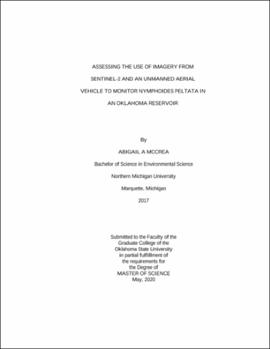| dc.contributor.advisor | Stoodley, Scott | |
| dc.contributor.author | McCrea, Abigail A. | |
| dc.date.accessioned | 2020-09-09T21:48:11Z | |
| dc.date.available | 2020-09-09T21:48:11Z | |
| dc.date.issued | 2020-05 | |
| dc.identifier.uri | https://hdl.handle.net/11244/325534 | |
| dc.description.abstract | Remote sensing of aquatic invasive plants has been relatively understudied for treatment monitoring applications. Invasive aquatic plants cause ecological distress as well as millions of dollars in damages and lost utility value and ecosystem services. Yellow floating heart (Nymphoides peltata) is a floating leaved macrophyte native to Southeast Asia and the Mediterranean. This plant has prolific spread potential and can create dense canopies that shade out other organisms. It was reported in Lake Carl Blackwell of Oklahoma in 2014. It covered over 20 hectares at its peak in 2019. The herbicide ProcellaCOR was applied to the infestation in the summer of 2019. The purpose of this research was to use Sentinel-2 satellite data and an unmanned aerial vehicle equipped with a MicaSense RedEdge-M camera to monitor the infestation and compare the sensors from spatial and spectral parameters. This can help lake managers integrate remote sensing tools into their monitoring programs in a cost-effective manner. A Sentinel-2 dataset was downloaded from the USGS EarthExplorer. UAV data was collected and processed in AgiSoft Structure-from-Motion. The Sentinel-2 and UAV datasets were classified by Maximum Likelihood Classification to compare ability to detect and delineate N. peltata with overall accuracies of 96.1% (kappa = 0.88) and 94.3% (0.80), respectively. The spatial extent was manually digitized on all available data and compared with regression analysis with a significantly high relationship (R2 = 0.94; p < 0.001). This measure also indicated a 91% reduction of the infestation after the herbicide application, a reduction of almost 2% lake coverage to less than 0.1%, due to herbicide treatment. The sensors were also compared in their measurements of the Normalized Difference Vegetation Index (R2 = 0.40; p = 0.13) and the Fractional Vegetative Index (R2 = 0.39; p = 0.13) both of which had low significance. The spatial data from Sentinel-2 was used to make an estimation of the potential economic impact caused by this infestation by correlating it to the average lake value. | |
| dc.format | application/pdf | |
| dc.language | en_US | |
| dc.rights | Copyright is held by the author who has granted the Oklahoma State University Library the non-exclusive right to share this material in its institutional repository. Contact Digital Library Services at lib-dls@okstate.edu or 405-744-9161 for the permission policy on the use, reproduction or distribution of this material. | |
| dc.title | Assessing the use of imagery from sentinel-2 and an unmanned aerial vehicle to monitor Nymphoides peltata in an Oklahoma reservoir | |
| dc.contributor.committeeMember | Dzialowski, Andrew | |
| dc.contributor.committeeMember | John, Ranjeet | |
| dc.contributor.committeeMember | Gholizadeh, Hamed | |
| osu.filename | McCrea_okstate_0664M_16787.pdf | |
| osu.accesstype | Open Access | |
| dc.type.genre | Thesis | |
| dc.type.material | Text | |
| dc.subject.keywords | invasive species | |
| dc.subject.keywords | nymphoides peltata | |
| dc.subject.keywords | sentinel-2 satellite | |
| dc.subject.keywords | unmanned aerial vehicle | |
| thesis.degree.discipline | Environmental Science | |
| thesis.degree.grantor | Oklahoma State University | |
